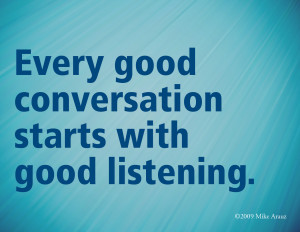What’s up everybody! Today we are going to talk about how to improve your listening skills in English. Many of my students have come to me in the past asking for tips on how to understand more when they are listening to a native speaker of English in a song, movie or real-life. Listening and UNDERSTANDING can be a very challenging task, but with a few tricks you can begin to comprehend MUCH MORE than before. So, what can you do TODAY to start listening effectively?

First, only pay attention to CONTENT WORDS. What are content words? Well they are the words in the English Language that we give emphasis to when speaking. Why? Because they are the words that have the meaning – they are the principal verbs, nouns, adjectives and adverbs. All the other words are just grammatical “fillers” – FUNCTION words – the auxiliary verbs, articles, pronouns, and prepositions. So what does this mean? It means that you only have to pay attention – when listening – to the words that give meaning – the CONTENT words. Moreover, in English, the content words are the words that are stressed, while the function words are usually reduced in pronunciation and pronounced with a neutral vowel sound that we call the schwa (a different lesson is needed for this). So when you are listening to a native speaker, try to focus on the words that they stress, and less on the little words that the speaker seems to be “skipping” over.
Second, confirm with the speaker that you have understood what you have heard. Most native speakers will pause after they say a few sentences to see that 1. You understand and 2. You are listening. (Women seem to do this a lot!!). These moments of pause are a great opportunity for you to acknowledge that you DO understand with phrases such as: “Oh ok, right.” – “Uh-huh.” – “Yeah.” – “Hmmm.” – “Wow.” – “Really?”. It is also a great chance to CLARIFY what you have already heard and make sure that you understand with phrases such as: “So, what you are saying is….? Right?” – “Let me make sure I understand you correctly. You mean….?” – “So, (repeat a phrase that the speaker already said in the way you remember it), right?” – “I think I get it/understand it…You mean…?”. This is a NECESSARY component to good listening, and therefore a stimulating conversation.
 Third, you must be PATIENT and let the other person completely finish what they are saying. This is good advice for anyone in any language as it is polite to let people finish their thoughts. Some students often THINK that they know what is coming next, and this assumption not only delays their understanding of whole concepts, but often makes them MISS the entire idea that was originally being communicated. This often happens when we wait for our turn to speak; Instead of thinking about what the person is saying, we are thinking about our response. This is NOT effective for true understanding to take place but doesn’t mean that you must stay SILENT. You can use the same phrases above (“Oh ok, right.” – “Uh-huh.” – “Yeah.” – “Hmmm.” – “Wow.”) for showing that you understand while a person is talking, but remember that saying “Okay” after every sentence someone says is strange and unnatural – and should be avoided. If you are saying “okay” every five seconds, then you are probably missing parts of the meaning. Clarify when needed, but make sure that listening in the main priority.
Third, you must be PATIENT and let the other person completely finish what they are saying. This is good advice for anyone in any language as it is polite to let people finish their thoughts. Some students often THINK that they know what is coming next, and this assumption not only delays their understanding of whole concepts, but often makes them MISS the entire idea that was originally being communicated. This often happens when we wait for our turn to speak; Instead of thinking about what the person is saying, we are thinking about our response. This is NOT effective for true understanding to take place but doesn’t mean that you must stay SILENT. You can use the same phrases above (“Oh ok, right.” – “Uh-huh.” – “Yeah.” – “Hmmm.” – “Wow.”) for showing that you understand while a person is talking, but remember that saying “Okay” after every sentence someone says is strange and unnatural – and should be avoided. If you are saying “okay” every five seconds, then you are probably missing parts of the meaning. Clarify when needed, but make sure that listening in the main priority.
Finally, don’t say that you understand when you don’t. This is the biggest mistake that you can make. Some students will say that they understand a word, when really they are just embarrassed to to say those three little words that are so terrible:
“I don’t know.”
It is much more honorable and respectable to admit to not knowing something and showing eagerness to learn, instead of trying to seem like you are a “know-it-all” – as we say. When you tell a native speaker that you understand (and you really don’t) then you are inviting that person to CONTINUE talking about something foreign to you. You are inviting that person to give more and more details about something that you aren’t 100% understanding. This is a big “no-no” when trying to improve your listening comprehension because being comfortable with “I don’t know” is essential to arriving at “Now I know.”
I hope that today’s blog has helped you with your listening skills in English. If you are interested in practicing your skills with me (or one of my friends) during a live class, please email me for more information at [email protected].
Take care, and have a great day!



